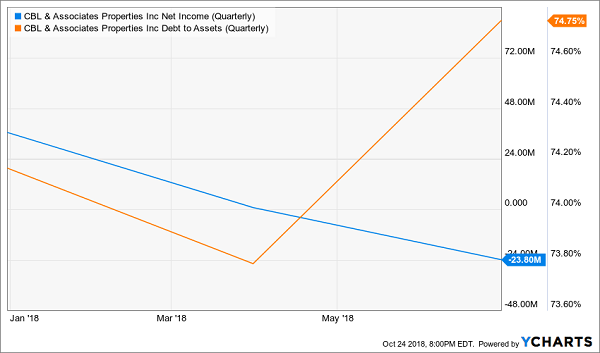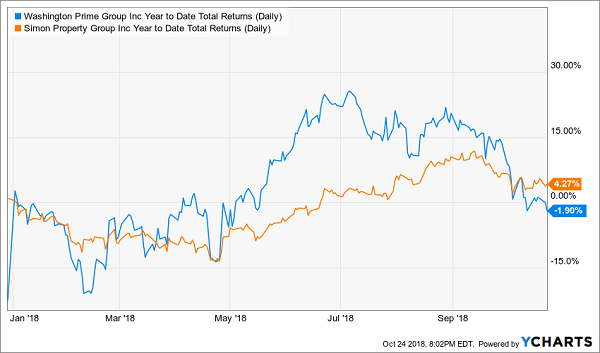Another one bites the dust.
That’s what I thought when I saw earlier this month that Sears Holdings (SHLD) was throwing in the towel and filing for bankruptcy.
The news was not too surprising for anyone that’s been following the retail sector, but with nearly 200 Sears and KMart stores that are now slated to close, it could be the blow that knocks some mall REIT dividends to the mat for a 10-count.
That’s because in addition to Sears, Mattress Firm, Brookstone, Claire’s and Bon-Ton are just a few of the retailers that also went under in 2018.
The mall was already on life support before Amazon.com (AMZN) changed the way that consumers shop in the U.S., but this time around, there just aren’t many shops that are willing to take over the vacant “anchor” space.
Reeling Retail REIT No. 1: Rising Debt and Lower Profits

CBL & Associates (CBL) is a REIT that already cut its dividend once in 2017 (as my colleague Brett Owens forecasted)and its current quarterly payout of $0.20 a share (24% yield!) will likely face the chopping block once again. That’s because 65% of the company’s 113 locations are shopping malls, including 27 Sears stores.
6 of those Sears locations are slated to close with the bankruptcy process, but CBL is seeing broad weakness throughout its portfolio. The company posted a 6.9% same-store net operating income decline in the most recent quarter, which was a record low result.
CBL had $4.7 billion of debt at last check and its bonds carry a “junk” rating. As is always the case, debt investors will always demand their interest before whatever is leftover can be paid in dividends.
What’s worse than a potential dividend cut? Management said earlier this year that it may try to fund the company’s dividend by giving out more shares. Not only would you not receive the income you’re expecting, you could be stuck holding more paper that’s been losing value by the day.
Reeling Retail REIT No. 2: Amazon Prime is the Real Winner

Washington Prime (WPG) may have beat Wall Street expectations earlier this week, but the stock has left investors feeling like they just ate Select-grade beef. The company was spun out of Simon Property (SPG) in 2014 and merged with Glimcher Realty Trust a year later to create the current entity.
Simon is the premier retail REIT in the market, but the parent company held onto its top assets and primarily placed second- and third-tier malls into Washington Prime. The difference can be seen in the performance of the two stocks since the spin, but also in 2% net operating income decline that Washington Prime now expects in 2018, following the Sears bankruptcy.
The company currently pays a 25-cent quarterly dividend (16% yield) and management reiterated its 2018 funds from operations guidance of $1.48 to $1.56 a share this week. That should cover the dividend for the time being, but does not give Washington Prime much leeway, as revenue is deteriorating along with the mall retail business.
The company’s bonds carry a BBB- rating, which is the final stage before reaching junk status. Washington Prime has a 71% debt-to-capital ratio and management may soon be faced with sacrificing the dividend to keep the bondholders happy.
You simply cannot afford to allow these retail REITs to drag your portfolio down, no matter how enticing the lofty dividend yields may seem today.
However, real estate is a large market, and there are plenty of good operators out there that can afford to pay dividend yields of 8% and more.
If you’re nearing retirement, or have already retired and are living off income from your investments, I strongly encourage you to check out the top REITs from Brett Owens, Contrarian Outlook’s Chief Investment Strategist. They’re key recommendations in his 8% No Withdrawal Portfolio and check both boxes for “dividend growth” and “high current yield”.
As a group, each pays an impressive 7%+ yield today, which is downright outstanding in a 3% world.
We’re living through a market when the Dow Jones Industrial Average can fall 800 points in a single sessions. However, if you combine 5% to 10%+ dividend growth with these high-single-digit current yields, and we have a formula for safe 15% to 20%+ annual gains, with a significant portion of that coming as cash dividends.
To achieve this, Brett focuses on recession-proof firms, such as those that rent hospitals, business lodging and warehouses filled with Amazon packages. Landlords that own properties that will be in high demand no matter what happens to interest rates or the economy from here, in other words.
We’d love to share Brett’s favorite recession-and-rate-proof REITs with you – including specific stock names, tickers and buy prices. Click here and we’ll send our full 8% No Withdrawal Portfolio research you to right now.
